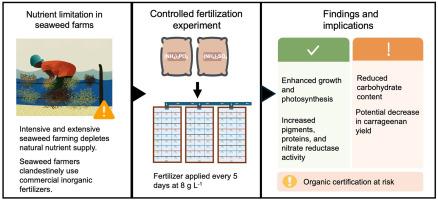大规模商业热带拟真金藻养殖中不受管制地使用氨基无机肥料:通过控制陆基孵化场养殖评估生理和生化后果
IF 6.2
Q1 AGRICULTURE, MULTIDISCIPLINARY
引用次数: 0
摘要
可用宏量营养素的耗尽或有限被认为是类紫菜养殖的主要制约因素,特别是在集约化养殖地区。在没有基线数据和科学建议的情况下,一些农民使用商业无机肥料来促进生长和缩短耕作期。在菲律宾南部,这是通过将海藻短暂浸泡在肥料溶液中,然后在种植前让富含营养的表面水分增强,直到部分干燥。尽管这种做法很普遍,但这一过程缺乏来自可靠实验的经验证据。因此,本研究研究了施用磷酸铵(NH4)3PO4和硫酸铵(NH4)2SO4这两种铵基商品肥料对陆源控制栽培拟拟木樨(Kappaphycus alvarezii var. tambalang)的影响。每5 d间歇施肥,施肥剂量为8.0 g L−1。(NH4)3PO4和(NH4)2SO4处理均显著提高了alvarezii的生长(分别为7.182±0.203% d - 1和6.448±0.182% d - 1)。光合作用(分别为0.126±0.022 mg O2 gFW−1 h−1和0.136±0.038 mg O2 gFW−1 h−1)、硝酸还原酶活性(分别为0.039±0.007 μmol NO2−gFW−1 h−1和0.046±0.007 μmol NO2−gFW−1 h−1)和氮基生化成分(包括蛋白质、藻胆蛋白和叶绿素a)在施肥处理下均有显著提高。在硫酸铵处理的样品中,蛋白质含量最高,而在两种施肥处理中,碳水化合物含量都有所下降。不同处理的卡拉胶产量和品质差异不显著。这些结果为评价施肥对拟真金藻生产力的提高效果提供了生理依据。本文章由计算机程序翻译,如有差异,请以英文原文为准。

Unregulated use of ammonium-based inorganic fertilizers in large-scale commercial tropical eucheumatoid seaweed farming: evaluating physiological and biochemical consequences through controlled land-based hatchery cultivation
Depleted or limited available macronutrients is considered a major constraint in eucheumatoid seaweed farming, particularly in intensively farmed areas. Without baseline data and scientific advice, some farmers use commercial inorganic fertilizers to enhance growth and shorten cultivation periods. In the southern Philippines, this is done by briefly immersing seaweeds into a fertilizer solution, then allowed to batten on nutrient-rich surface moisture until partially dessicated before out planting. Despite its prevalent practice, this process lacks empirical evidence from a robust experiment. Therefore, this study investigated the effects of using ammonium-based commercial fertilizers, i.e., ammonium phosphate (NH4)3PO4 and ammonium sulfate (NH4)2SO4, on the eucheumatoid Kappaphycus alvarezii var. tambalang under controlled, land-based cultivation. Fertilizers were applied intermittently every 5 days at 8.0 g L−1. Both treatments significantly improved growth (7.182 ± 0.203 % d−1 and 6.448 ± 0.182 % d−1 for (NH4)3PO4 and (NH4)2SO4, respectively) of K. alvarezii. Moreover, photosynthesis (0.126 ± 0.022 mg O2 gFW−1 h−1 and 0.136 ± 0.038 mg O2 gFW−1 h−1, respectively), nitrate reductase activity (0.039 ± 0.007 μmol NO2− gFW−1 h−1 and 0.046 ± 0.007 μmol NO2− gFW−1 h−1, respectively) and nitrogen-based biochemical constituents, including protein, phycobiliproteins, and chlorophyll a were elevated under fertilizer treatments. Protein was highest in ammonium sulfate-treated samples, while carbohydrate declined in both fertilizer treatments. However, carrageenan yield and quality did not differ significantly across treatments. These results provide a physiological basis for assessing the effectiveness of fertilizer application in enhancing the productivity of eucheumatoid seaweeds.
求助全文
通过发布文献求助,成功后即可免费获取论文全文。
去求助
来源期刊

Journal of Agriculture and Food Research
Multiple-
CiteScore
5.40
自引率
2.60%
发文量
193
审稿时长
69 days
 求助内容:
求助内容: 应助结果提醒方式:
应助结果提醒方式:


